
A chain gang or road gang is a group of prisoners chained together to perform menial or physically challenging work as a form of punishment. Such punishment might include repairing buildings, building roads, or clearing land. The system was notably used in the convict era of Australia and in the Southern United States. By 1955 it had largely been phased out in the U.S., with Georgia among the last states to abandon the practice. North Carolina continued to use chain gangs into the 1970s. Chain gangs were reintroduced by a few states during the "get tough on crime" 1990s: In 1995, Alabama was the first state to revive them. The experiment ended after about one year in all states except Arizona, where in Maricopa County inmates can still volunteer for a chain gang to earn credit toward a high school diploma or avoid disciplinary lockdowns for rule infractions.

Sing Sing Correctional Facility, formerly Ossining Correctional Facility, is a maximum-security prison operated by the New York State Department of Corrections and Community Supervision in the village of Ossining, New York. It is about 30 miles (48 km) north of New York City on the east bank of the Hudson River. It holds about 1,700 inmates and housed the execution chamber for the State of New York until the abolition of capital punishment in New York in 1977.

A labor camp or work camp is a detention facility where inmates are forced to engage in penal labor as a form of punishment. Labor camps have many common aspects with slavery and with prisons. Conditions at labor camps vary widely depending on the operators. Convention no. 105 of the United Nations International Labour Organization (ILO), adopted internationally on 27 June 1957, abolished camps of forced labor.

The United States Disciplinary Barracks (USDB), colloquially known as Leavenworth, is a military correctional facility located on Fort Leavenworth, a United States Army post in Kansas. It is one of two major prisons built on Fort Leavenworth property, the other is the military Midwest Joint Regional Correctional Facility, which opened on 5 October 2010. It reports to the United States Army Corrections Command and its commandant usually holds the rank of colonel.
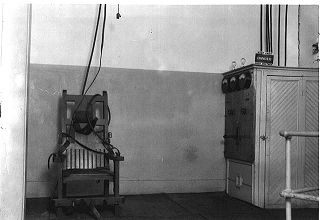
Old Sparky is the nickname of the electric chairs in Arkansas, Connecticut, Florida, Georgia, Illinois, Kentucky, Nebraska, New York, Ohio, Oklahoma, South Carolina, Texas, Virginia, and West Virginia. Old Smokey was the nickname of the electric chairs used in New Jersey, Pennsylvania, and Tennessee. "Old Sparky" is sometimes used to refer to electric chairs in general, and not one of a specific state.
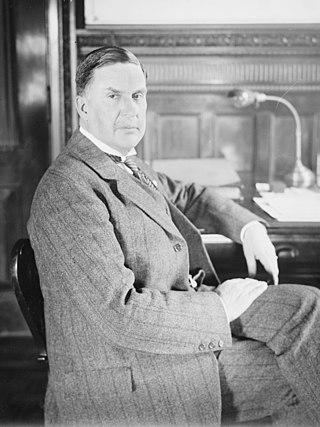
Thomas Mott Osborne was an American prison officer, prison reformer, industrialist and New York State political reformer. In an assessment of Osborne's life, a New York Times book reviewer wrote: "His career as a penologist was short, but in the interval of the few years he served he succeeded in revolutionizing American prison reform, if not always in fact, then in awakening responsibility.... He was made of the spectacular stuff of martyrs, to many people perhaps ridiculous, but to those whose lives his theories most closely touched, inspiring and often godlike."

Prison reform is the attempt to improve conditions inside prisons, improve the effectiveness of a penal system, or implement alternatives to incarceration. It also focuses on ensuring the reinstatement of those whose lives are impacted by crimes.

Penal labour is a term for various kinds of forced labour that prisoners are required to perform, typically manual labour. The work may be light or hard, depending on the context. Forms of sentence involving penal labour have included involuntary servitude, penal servitude, and imprisonment with hard labour. The term may refer to several related scenarios: labour as a form of punishment, the prison system used as a means to secure labour, and labour as providing occupation for convicts. These scenarios can be applied to those imprisoned for political, religious, war, or other reasons as well as to criminal convicts.
Auburn Correctional Facility is a state prison on State Street in Auburn, New York, United States. It was built on land that was once a Cayuga village. It is classified as a maximum security facility.
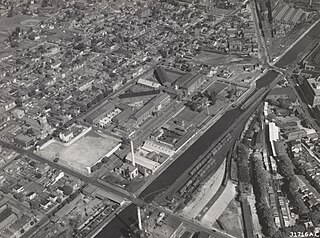
The New Jersey State Prison (NJSP), formerly known as Trenton State Prison, is a state men's prison in Trenton, New Jersey operated by the New Jersey Department of Corrections. It is the oldest prison in New Jersey and one of the oldest correctional facilities in the United States. It is the state's only completely maximum security institution, housing the most difficult and/or dangerous male offenders in the inmate population. NJSP operates two security units and provides a high level of custodial supervision and control. Professional treatment services, such as education and social work, are a priority at the facility. The Bureau of State Use Industries operated the bedding and clothing shops that were once located in Shop Hall at the facility. These industries have been relocated to South Woods State Prison.

A prison uniform is a set of standardized clothing worn by prisoners. It usually includes visually distinct clothes worn to indicate the wearer is a prisoner, in clear distinction from civil clothing.
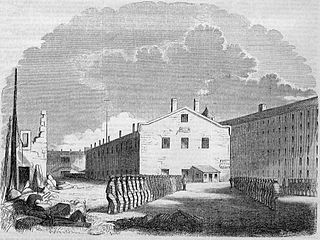
The Auburn system is a penal method of the 19th century in which persons worked during the day in groups and were kept in solitary confinement at night, with enforced silence at all times. The silent system evolved during the 1820s at Auburn Prison in Auburn, New York, as an alternative to and modification of the Pennsylvania system of solitary confinement, which it gradually replaced in the United States. Whigs favored this system because it promised to rehabilitate criminals by teaching them personal discipline and respect for work, property, and other people.
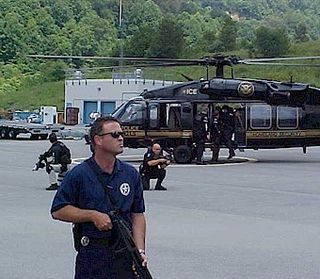
Prisoner transport is the transportation of prisoners from one secure location to another. It may be carried out by law enforcement agencies or private contractors such as Prisoner Transportation Services.

A prison, also known as a jail, gaol, penitentiary, detention center, correction center, correctional facility, or remand center, is a facility where people are confined against their will and denied a variety of freedoms under the authority of the state, generally as punishment for various crimes. Authorities most commonly use prisons within a criminal-justice system: people charged with crimes may be imprisoned until their trial; those who have pled or been found guilty of crimes at trial may be sentenced to a specified period of imprisonment.

The Union Correctional Institution, formerly referred to as Florida State Prison, Raiford Prison and State Prison Farm is a Florida Department of Corrections state prison located in unincorporated Union County, Florida, near Raiford.
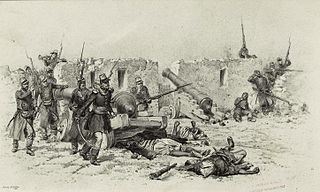
A penal military unit, also known as a penal formation, disciplinary unit, or just penal unit, is a military formation consisting of convicts mobilized for military service. Such formations may consist of military prisoners convicted under military law, civilian prisoners convicted in civilian courts, prisoners of war who have chosen to side with their captors, or a combination of these groups.

Captain Elam Lynds (1784–1855) was a prison warden. He helped create the Auburn system, which consisted of congregate labor during the day and isolation at night, starting in 1821 and was Warden of Sing Sing from 1825 to 1830.

Imprisonment began to replace other forms of criminal punishment in the United States just before the American Revolution, though penal incarceration efforts had been ongoing in England since as early as the 1500s, and prisons in the form of dungeons and various detention facilities had existed as early as the first sovereign states. In colonial times, courts and magistrates would impose punishments including fines, forced labor, public restraint, flogging, maiming, and death, with sheriffs detaining some defendants awaiting trial. The use of confinement as a punishment in itself was originally seen as a more humane alternative to capital and corporal punishment, especially among Quakers in Pennsylvania. Prison building efforts in the United States came in three major waves. The first began during the Jacksonian Era and led to the widespread use of imprisonment and rehabilitative labor as the primary penalty for most crimes in nearly all states by the time of the American Civil War. The second began after the Civil War and gained momentum during the Progressive Era, bringing a number of new mechanisms—such as parole, probation, and indeterminate sentencing—into the mainstream of American penal practice. Finally, since the early 1970s, the United States has engaged in a historically unprecedented expansion of its imprisonment systems at both the federal and state level. Since 1973, the number of incarcerated persons in the United States has increased five-fold. Now, about 2,200,000 people, or 3.2 percent of the adult population, are imprisoned in the United States, and about 7,000,000 are under supervision of some form in the correctional system, including parole and probation. Periods of prison construction and reform produced major changes in the structure of prison systems and their missions, the responsibilities of federal and state agencies for administering and supervising them, as well as the legal and political status of prisoners themselves.

Norway's criminal justice system focuses on the principles of restorative justice and the rehabilitation of prisoners. Correctional facilities in Norway focus on maintaining custody of the offender and attempting to make them functioning members of society. Norway's prison system is renowned as one of the most effective and humane in the world.
Capital punishment in Malawi is a legal punishment for certain crimes. The country abolished the death penalty following a Malawian Supreme Court ruling in 2021, but it was soon reinstated. However, the country is currently under a death penalty moratorium, which has been in place since the latest execution in 1992.

















